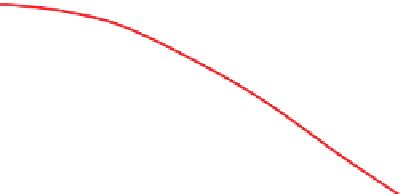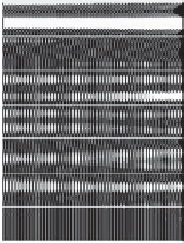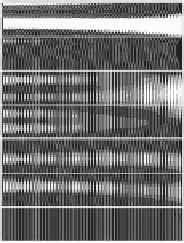Geology Reference
In-Depth Information
Offset
0.42
0.43
0.44
0.45
0.46
0.47
0.48
0.49
TWT
Figure 6.9
Synthetic angle gather before (left) and after (right)
correction for moveout stretch, after Roy
(
2005
). Gradients
calculated from these data (across the full offset range) would be
different after stretch correction.
et al.
Figure 6.8
Schematic normal moveout curves for two reflections
in a CDP gather, showing convergence of the curves as offset
increases. Moveout correction moves the reflections onto the
horizontal lines, which implies that the trace will be stretched by an
amount that increases with offset.
offset will cause variations in thin-bed tuning behav-
iour that might obscure true AVO effects. Various
proposals for
moveout correction have
been put forward, but as pointed out by Williamson
and Robein (
2006
) the high-frequency information
was lost at the time of acquisition and no moveout
correction process can recover it. Traditionally, data
with stretch of more than 2:1 is muted, with the
remaining data having a spectral balancing process
applied. One approach is to apply a deterministic
correction for moveout stretch and absorption
(Lazaratos and Finn,
2004
). Alternatively, frequency
spectra at various offsets can be compared and oper-
ators derived to match them to a reference trace. The
reference trace might for example be the full stack.
Using a near stack will tend to magnify noise on the
far traces, and using a far stack will in all likelihood
remove valid information on the nears. Correction
for spectral variation across gathers can have a notice-
able effect on the AVO gradient (
Fig. 6.9
). In seismic
inversion (
Chapter 9
) pre-stack spectral variations are
taken into account by specifying a separate wavelet for
each angle stack.
'
stretch-free
'
response at a particular angle or narrow range of
angles (see
Section 2.3.5
). Given that the processor
uses a smoothed velocity function to calculate the
offset vs angle relationship, it is important to compare
the results to a model generated from well velocity
data. Some depth migration algorithms are able to
output angle gathers directly, although the angles
predicted will depend on the accuracy of the velocity
model inherent in the depth migration. Again, it is
advised to check the calculations at well locations.
6.3.1 Spectral equalisation
The frequency of seismic data generally decreases
with increasing offset with the effect primarily related
to the application of moveout correction to hyper-
bolic reflections. Given that moveout hyperbolae are
not parallel, moveout correction leads to a stretching
of the signal at larger offsets to match the time separ-
ation at near offsets and this inevitably causes a shift
to lower frequency across the gather (
Fig. 6.8
). These
effects may also be reinforced by a dip-dependent
shift to lower frequencies with increasing incidence
angle due to the effect of the migration process (Tygel
et al.,
1994
) and by absorption effects caused by the
longer raypath for far offset traces.
A key problem for AVO analysis in the presence
of a large spectral imbalance across the gather is that
data on near traces may not necessarily relate prop-
erly to the data on the far traces, giving rise to erro-
neous gradients. In addition, frequency changes with
6.3.2 Residual moveout removal
There are often residual moveout effects visible on the
gathers, perhaps as a result of inaccuracies in picking
velocities or residual anisotropic effects (
Fig. 6.10
). If
the reflections in the corrected gather are not flat the
calculation of AVO gradient can be strongly affected.
Figure 6.11
shows an example of the effect of residual
moveout on near and far stacks. The horizon picks
were made on the near stack and transferred to the far
stack. The red pick shows an apparent phase reversal
119















